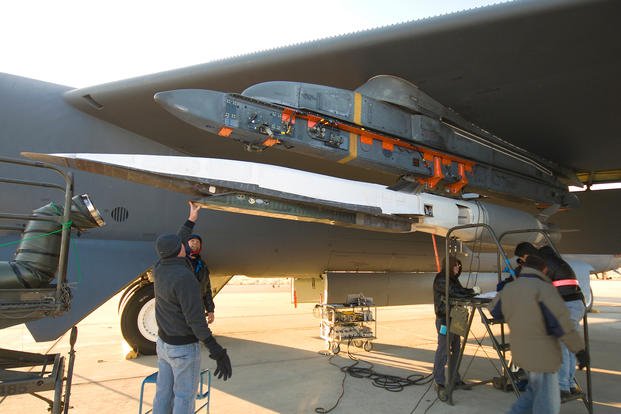As the global race for hypersonic weapons intensifies, the U.S. military just decided to abandon one of its fundamental prototype programs.
The U.S. Air Force on Monday said it will cancel its Hypersonic Conventional Strike Weapon, known as HCSW (pronounced "Hacksaw"), in order to shift resources to its other program, the Air-launched Rapid Response Weapon (ARRW). Both prototypes are designed by Lockheed Martin Corp.
"Due to budget priorities, the Air Force down-selected to one hypersonic weapon prototyping effort this year," spokeswoman Ann Stefanek said. Instead, she said, the service will concentrate efforts on ARRW, which is "on track for an early operational capability in fiscal 2022."
Stefanek explained that ARRW -- pronounced "Arrow" -- offers a "unique glide body design as compared to other prototyping efforts."
Related: Navy Sets Date for Crucial Hypersonic Weapons Flight Test
"We will continue to work collaboratively with our sister services to see how we can most effectively leverage each other's capabilities, ensuring the most prudent use of taxpayer dollars," she said.
The Air Force informed Lockheed of its decision on Monday; the service will still continue to work with Lockheed on HCSW until the prototype's critical design review in the spring before the termination, Stefanek said.
In its fiscal 2021 budget request unveiled Monday, the Air Force said it needs $382 million for hypersonics research, test and development. Last year, lawmakers gave the service $576 million for the effort.
"The HCSW team pioneered significant advancements in hypersonic technology development and integration of existing, mature technologies for use in various hypersonic efforts across the Department of Defense, including Army, Navy, and Missile Defense Agency programs," Stefanek said. "These advancements will serve to expedite the generation and demonstration of various hypersonic weapon capabilities in the near future."
The contract for the Hacksaw project was awarded in 2018. It was estimated to cost as much as $928 million over the course of its lifetime.
Hypersonic weapons are meant to move at five times the speed of sound or more. While little has been disclosed on either Air Force program, Aerojet Rocketdyne announced last year it would partner with Lockheed on the HCSW endeavor.
The company said it has worked on creating both solid-fueled and air-breathing ramjet and scramjet capabilities for hypersonic technologies, and pointed to its successful test of the the X-51A Waverider, a hydrocarbon-fueled and scramjet-powered cruise missile prototype that was the first to achieve hypersonic speeds in 2013.
Aerojet in September said it was looking in part to use Waverider as a blueprint for HCSW.
Scramjet -- short for supersonic combustion ramjet -- technologies use an airbreathing jet engine that compresses incoming air, but needs to retain extreme high speeds to compress that air. In order to do that, they are first propelled by a booster to reach hypersonic speeds.
Meanwhile, the Air Force conducted its first test of the AGM-183A ARRW in June, flying the weapon on a B-52 Stratofortress bomber aircraft at Edwards Air Force Base, California. ARRW, which has a tactical boost-glide body, completed its preliminary design review in March 2019, Lockheed said at the time.
A glide-body vehicle reaches high speeds before separating its payload and gliding toward its intended target, according to the Defense Advanced Research Projects Agency.
Like the Air Force, the Navy has also set its sights on glide-body experiments.
Last month, Acting Navy Secretary Thomas Modly outlined a robust schedule for the service, which includes a flight experiment scheduled later this fiscal year. The test will demonstrate the effectiveness of the Navy-designed weapon: the Hypersonic Glide Body.
-- Oriana Pawlyk can be reached at oriana.pawlyk@military.com. Follow her on Twitter at @oriana0214.
Read More: Air Force to Send More Than 100 Planes to Boneyard as It Invests in Future Fighters












